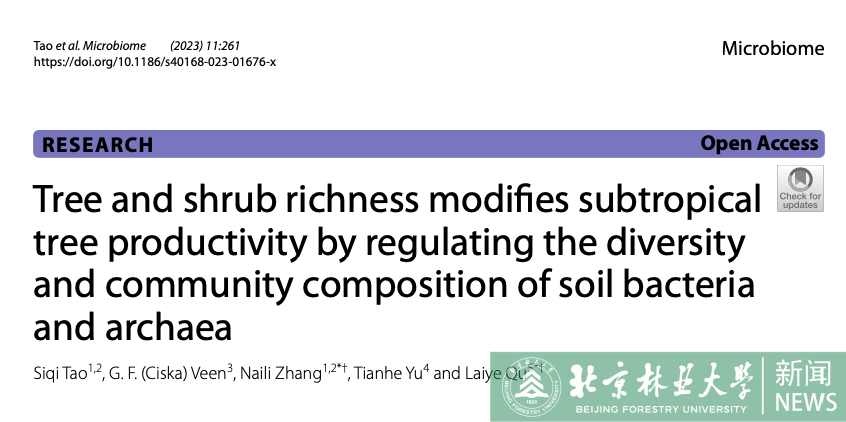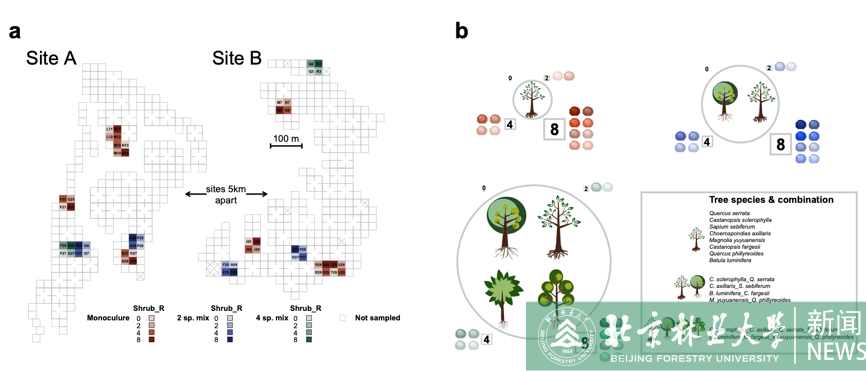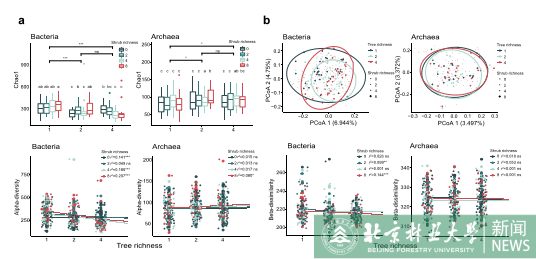Latest news
Recently, the Forest Science team from the College of Forestry at Beijing Forestry University published a research paper in Microbiome, a leading journal in microbiology with a five-year IF of 19.4. The paper, titled "Tree and shrub richness modifies subtropical tree productivity by regulating the diversity and community composition of soil bacteria and archaea", explores the response of soil bacteria and archaea communities to varying diversity levels of trees and shrubs in subtropical forests. It also examines the regulatory mechanisms these microbial communities employ to influence ecosystem productivity.

Declines in plant biodiversity often have negative consequences for plant community productivity, and it becomes increasingly acknowledged that this may be driven by shifts in soil microbial communities. So far, the role of fungal communities in driving tree diversity-productivity relationships has been well assessed in forests. However, the role of bacteria and archaea, which are also highly abundant in forest soils and perform pivotal ecosystem functions, has been less investigated in this context. Here, how tree and shrub richness affects stand-level tree productivity was investigated by regulating bacterial and archaeal community diversity and composition. A landscape-scale, subtropical tree biodiversity experiment (BEF-China) was used where tree (1, 2, or 4 species) and shrub richness (0, 2, 4, 8 species) were modified.

The research indicated a noteworthy decline in soil bacterial α-diversity as tree species richness increased from monoculture to 2- and 4- tree species mixtures, but a significant increase in archaeal α-diversity. Additionally, the impact of shrub species richness on microbial α-diversity was observed to be largely dependent on the level of tree species richness. The increase in tree species richness greatly reduced the variability in bacterial community composition and the complexity of co-occurrence network, but this effect was marginal for archaea. Both tree and shrub species richness increased the stand-level tree productivity by regulating the diversity and composition of bacterial community and archaeal diversity, with the effects being mediated via increases in soil C:N ratios.

The findings provide insight into the importance of bacterial and archaeal communities in driving the relationship between plant diversity and productivity in subtropical forests and highlight the necessity for a better understanding of prokaryotic communities in forest soils.

Tao Siqi, a lecturer from the College of Forestry, is the first author of the paper. Associate professor Zhang Naili and associate researcher Qu Laiye from the Ecological Environment Research Center of the Chinese Academy of Sciences served as co-corresponding authors. Beijing Forestry University is signature unit of the first author.This study was supported by the National Natural Science Foundation of China (grant number 32071644), the Strategic Priority Research Program of the Chinese Academy of Sciences (grant number XDB31030400), and the National Key Research and Development Project of China (grant number 2017YFA0605103).
Paper link: https://doi.org/10.1186/s40168-023-01676-x
Video Abstract
Written by Tao Siqi
Translated and edited by Song He
Reviewed by Yu Yangyang












